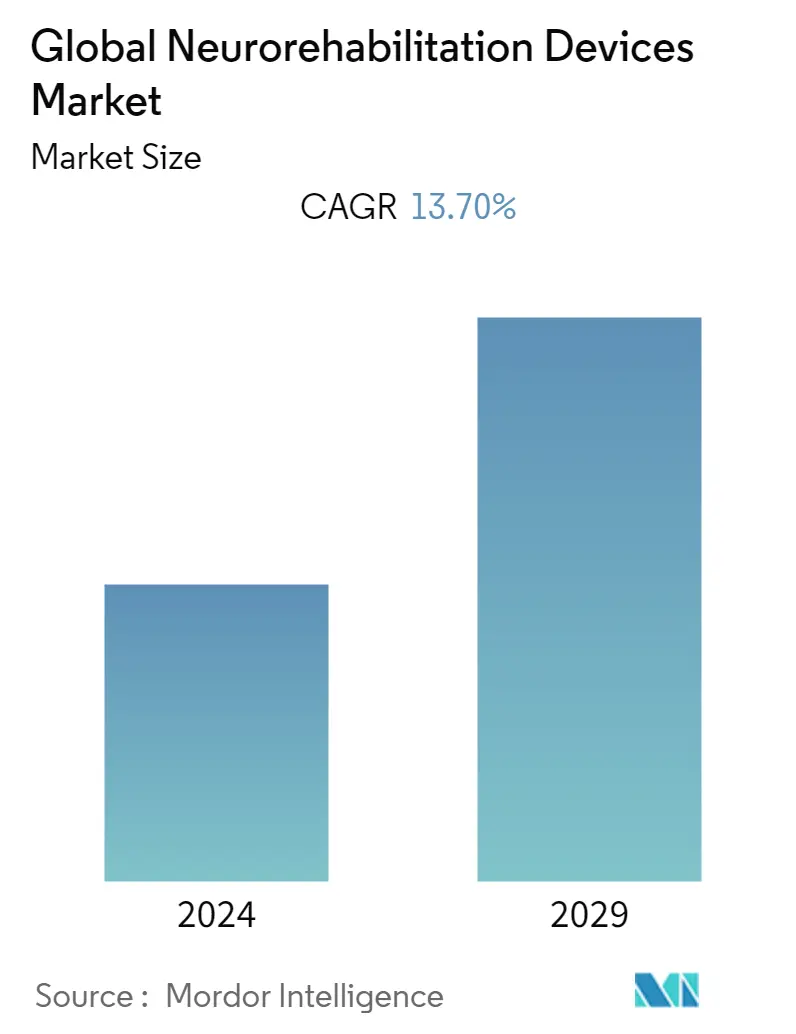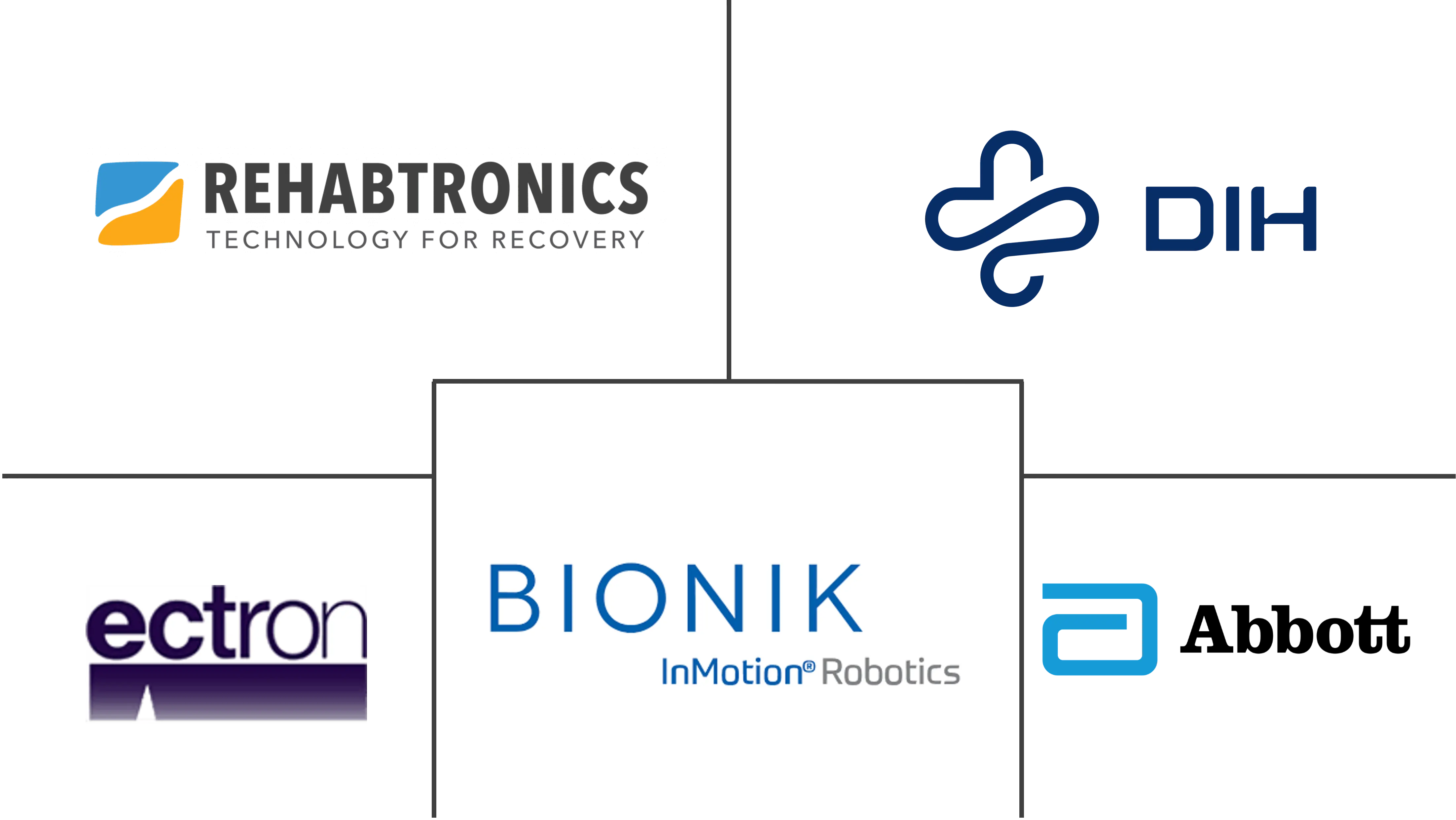Market Size of Global Neurorehabilitation Devices Industry

| Study Period | 2019 - 2029 |
| Base Year For Estimation | 2023 |
| CAGR | 13.70 % |
| Fastest Growing Market | Asia Pacific |
| Largest Market | North America |
| Market Concentration | Medium |
Major Players
*Disclaimer: Major Players sorted in no particular order |
Neurorehabilitation Devices Market Analysis
The neurorehabilitation devices market is expected to register a CAGR of 13.7% during the forecast period.
COVID-19 has significantly impacted the growth of the neurorehabilitation market owing to factors such as delayed consultations and therapies. For instance, as per the article published in January 2022 in PubMed, during the COVID-19 pandemic, different organizational models were implemented in neurorehabilitation, which had an impact on the duration of treatments, the physical and mental health of healthcare professionals, and the workload of caregivers. Furthermore, according to the study published in October 2021, telerehabilitation was perceived as a key innovation and an effective strategy to combat the pandemic and lower the worldwide handicap load. It also reported that the pandemic scenario presented an opportunity to optimize and scale up health-related technology advancements to tackle the rising burden of neurological impairment in LMICs. Since the COVID-19 restrictions were lifted, the neurorehabilitation devices market is anticipated to witness growth due to the rise in the prevalence of neurological disorders and technological advances in neurorehabilitation devices.
Factors such as the increase in the prevalence of neurological disorders and the surge in neurorehabilitation devices with technological advances. For instance, according to the "World Alzheimer Report 2021," published in September 2021, over 55 million people worldwide live with dementia. This is forecasted to reach 78 million by 2030. The increasing burden of Alzheimer's disease globally surges the demand for neurorehabilitation devices, thereby leading to the growth of the studied market. In addition, approvals for neurorehabilitation devices by international regulatory agencies also contribute to the market's growth over the forecast period. For instance, in April 2021, the United States Food and Drug Administration granted marketing approval for the IpsiHand Upper Extremity Rehabilitation System (IpsiHand System), a brain-computer interface (BCI) device that assists in rehabilitation for stroke patients with upper extremity (hand, wrist, and arm) disabilities. Furthermore, in August 2022, Neurofenix, a health tech startup with roots in the UK, picked up a capital investment of EUR 7 million to build out its product line and kickstart clinical trials in the US. The startup is using a ground-breaking, patient-centric approach to at-home rehabilitation and recovery that is proving to be more supportive and engaging.
Therefore, the rising prevalence of neurological disorders, the growing geriatric population, and technological advancements in neurorehabilitation devices are the key driving factors for the market's growth. However, the high cost of neurorehabilitation devices may hinder market growth over the forecast period.
Neurorehabilitation Devices Industry Segmentation
As per the scope of the report, neurorehabilitation devices help improve function, reduce symptoms, and improve the well-being of people with diseases such as trauma or nervous system disorders. Some of the conditions that may benefit from neurological rehabilitation may include vascular disorders (such as ischemic and hemorrhagic strokes), neurological infectious diseases (such as meningitis, encephalitis, polio, and brain abscesses), trauma, structural or neuromuscular disorders, functional disorders (such as headache, seizure disorder, dizziness, and neuralgia), and neurodegenerative disorders (such as Parkinson disease, multiple sclerosis, amyotrophic lateral sclerosis (ALS), Alzheimer disease, and Huntington chorea). The Neurorehabilitation Devices Market is Segmented by Product Type (Neuro-Robotic Devices, Wearable Devices, Non-Invasive Stimulators, and Brain-Computer Interfaces), End-User (Hospitals/Clinics, Cognitive Care Centers, and Others), and Geography (North America, Europe, Asia-Pacific, Middle East and Africa, and South America). The market report also covers the estimated market sizes and trends for 17 countries across major global regions. The report offers the value (USD million) for the above segments.
| By Product Type | |
| Neuro-Robotic Devices | |
| Wearable Devices | |
| Non-Invasive Stimulators | |
| Brain-Computer Interface |
| By End-User | |
| Hospitals/Clinics | |
| Cognitive Care Centers | |
| Others |
| Geography | ||||||||
| ||||||||
| ||||||||
| ||||||||
| ||||||||
|
Global Neurorehabilitation Devices Market Size Summary
The neurorehabilitation devices market is poised for significant growth, driven by the increasing prevalence of neurological disorders and advancements in technology. The market is expected to expand at a robust pace over the forecast period, with factors such as the rising geriatric population and the growing demand for innovative rehabilitation solutions playing a crucial role. The COVID-19 pandemic has influenced the market dynamics, with telerehabilitation emerging as a key strategy to address challenges and optimize health-related technology. As restrictions ease, the market is anticipated to benefit from the surge in neurological disorder cases and the continuous evolution of neurorehabilitation devices. Regulatory approvals and investments in health tech startups further bolster market expansion, highlighting the sector's potential.
The neuro-robotic devices segment is projected to experience substantial growth, fueled by technological advancements and the integration of robotics with neuroscience. This segment's expansion is supported by the effectiveness of robotic approaches in neurorehabilitation, as evidenced by various studies. The establishment of robotic-assisted neurorehabilitation centers enhances accessibility, contributing to segment growth. North America is expected to maintain a significant market share, driven by the high incidence of neurological disorders and technological innovations in the region. The presence of major players and initiatives to raise awareness further propel market growth. Overall, the neurorehabilitation devices market is characterized by a consolidated landscape with key players dominating the scene, underscoring the competitive nature and potential for continued expansion.
Global Neurorehabilitation Devices Market Size - Table of Contents
-
1. MARKET DYNAMICS
-
1.1 Market Overview
-
1.2 Market Drivers
-
1.2.1 Rising Prevalence of Neurological Disorders
-
1.2.2 Technological Advancements in Neurorehabilitation Devices
-
-
1.3 Market Restraints
-
1.3.1 High Cost of the Neurorehabilitation Devices
-
-
1.4 Porter Five Forces
-
1.4.1 Threat of New Entrants
-
1.4.2 Bargaining Power of Buyers/Consumers
-
1.4.3 Bargaining Power of Suppliers
-
1.4.4 Threat of Substitute Products
-
1.4.5 Intensity of Competitive Rivalry
-
-
-
2. MARKET SEGMENTATION (Market Size by Value - USD million)
-
2.1 By Product Type
-
2.1.1 Neuro-Robotic Devices
-
2.1.2 Wearable Devices
-
2.1.3 Non-Invasive Stimulators
-
2.1.4 Brain-Computer Interface
-
-
2.2 By End-User
-
2.2.1 Hospitals/Clinics
-
2.2.2 Cognitive Care Centers
-
2.2.3 Others
-
-
2.3 Geography
-
2.3.1 North America
-
2.3.1.1 United States
-
2.3.1.2 Canada
-
2.3.1.3 Mexico
-
-
2.3.2 Europe
-
2.3.2.1 Germany
-
2.3.2.2 United Kingdom
-
2.3.2.3 France
-
2.3.2.4 Italy
-
2.3.2.5 Spain
-
2.3.2.6 Rest of Europe
-
-
2.3.3 Asia-Pacific
-
2.3.3.1 China
-
2.3.3.2 Japan
-
2.3.3.3 India
-
2.3.3.4 Australia
-
2.3.3.5 South Korea
-
2.3.3.6 Rest of Asia-Pacific
-
-
2.3.4 Middle East and Africa
-
2.3.4.1 GCC
-
2.3.4.2 South Africa
-
2.3.4.3 Rest of Middle East and Africa
-
-
2.3.5 South America
-
2.3.5.1 Brazil
-
2.3.5.2 Argentina
-
2.3.5.3 Rest of South America
-
-
-
Global Neurorehabilitation Devices Market Size FAQs
What is the current Global Neurorehabilitation Devices Market size?
The Global Neurorehabilitation Devices Market is projected to register a CAGR of 13.70% during the forecast period (2024-2029)
Who are the key players in Global Neurorehabilitation Devices Market?
Bionik Labs, Ectron Ltd, REHABTRONICS INC., DIH International Limited (Hocoma AG) and Abbott Laboratories (St. Jude Medical Inc.) are the major companies operating in the Global Neurorehabilitation Devices Market.

